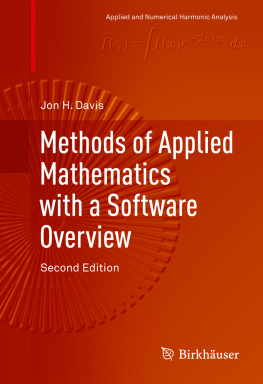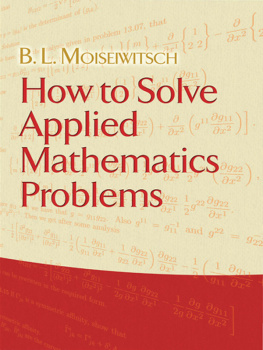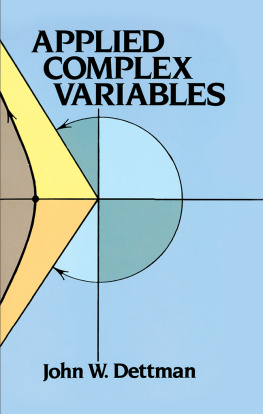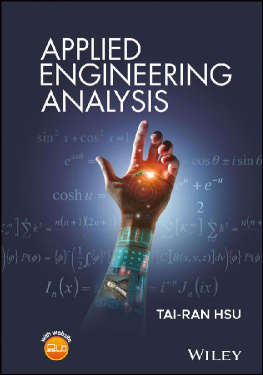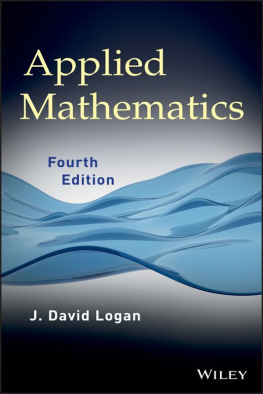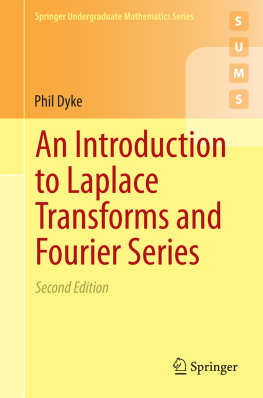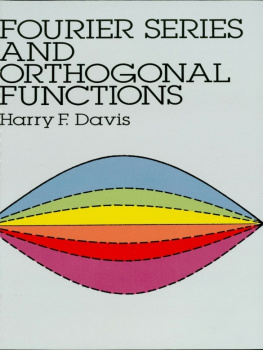1.1 An Overview
This text is intended to provide an introduction to certain methods of applied mathematics, especially those arising from the area of Fourier analysis. These methods are widely applicable both on an operational basis for the solution of particular problems and on a conceptual basis for the analysis and understanding of models arising in a wide variety of applied contexts.
The topics treated include some that are usually described as in the area of classical mathematical physics, as well as problems arising in a more contemporary engineering mathematics context. These labels may be appropriate for some of the examples and applications. However, the methods discussed have obvious applicability to diverse other models arising in other applications areas. Some of these are described in the problems.
The material below consists of a mixture of analytical results and applications illustrating the results. We include a certain amount of model formulation and analysis, as well as some technical discussion of topics underlying the analytical results.
It is perhaps appropriate to make some remarks about the level of the treatment of the topics. The level of rigor in the material is (by design) uneven. Topics are treated on a rigorous level when it is convenient to do so, and when such a treatment is essential or useful for the understanding of the issue under discussion. On some occasions, required results are quoted with attendant (hopefully convincing) argument for their plausibility. Methods are of little use without knowledge of the limits of their applicability, and the creation of novel methods requires knowing where the standard approaches came from.
1.2 Topics by Chapter
The second chapter consists of an introduction to the theory and elementary applications of Fourier series. Convergence of such series is discussed on the basis of an inner product space approach. Applications include periodic solutions of ordinary differential equations, impedance methods for electric circuits, and a discussion of the power spectrum notion derived from Parsevals Theorem.
The third chapter considers elementary boundary value problems, and might possibly be considered a further application of the Fourier series results of Chapter This chapter also contains some derivations of the standard boundary value problem models, and a discussion of discrete boundary value problem analogue systems.
The fourth chapter treats higher-dimensional, non-rectangular boundary value problems. Included is a treatment of SturmLiouville expansions encountered in such models. The chapter also includes some discussion of series solutions and Bessel equations, as well as inhomogeneous boundary value problems.
An introduction to functions of a complex variable occupies Chapter The basic results needed for applications are developed, including Cauchys integral formula and the Residue Theorem. Complex functions are discussed, including the principle of the argument and conformal mappings. Applications are made to problems of fluid flow in this chapter, and to transform inversion in later chapters.
The sixth chapter introduces Laplace transform methods. In this chapter Laplace inversion is treated on a tricks and tables basis. Applications include ordinary differential equations, transient circuit analysis, and an introduction to input-output analysis of linear systems.
Continuous time Fourier transforms appear in Chapter The Fourier inversion is treated both on an introductory algebraic basis, and later by using the inversion integral. The inversion integral for Laplace transforms is introduced as a special case of Fourier inversion. We also include in this chapter an introduction to generalized functions which includes a discussion of the underlying definitions.
Applications of Fourier transforms are made to ordinary differential equations, integral equations, linear systems, communications problems, impedance analysis, and partial differential equations.
Discrete variable transforms are the subject of the eighth chapter. Properties and applications of both the discrete Fourier and z -transforms are included. We also discuss the finite discrete Fourier transform, together with the associated Fast Fourier Transform algorithm of digital signal processing fame.
The final chapter provides an introduction to some transform methods of a more specialized nature than those considered above. The topics include two-sided and Walsh transforms, integral transforms associated with the SturmLiouville problems of Chapter , and the more recently developed topics in local waveform analysis, including short-time Fourier transforms.
1.3 Applying Mathematics
It goes without saying that applying mathematics requires both knowledge of subject areas of application, and of mathematical ideas and results that can be applied. In this text there are applications (especially in the problems) to a variety of subject areas. The topics are discussed as they appear to the level necessary to understand the discussion and questions.
The text contains some of what might be regarded as theory, particularly on topics related to analysis. The idea here is that a little knowledge is dangerous, and that making competent applications of the material requires understanding what assumptions are being made in the process. The topics are of sufficient depth that it is possible to make bogus calculations on the basis of inadequate understanding.
Anyone who applies mathematics is eventually struck with wonder that it all seems to fit so well. Why is the universe not random chaos, but instead filled with phenomena that seem to be well described by boundary value problems, or contours of functions of a complex variable?
This seems to be one of the Deep Questions. This text discusses topics that belong historically to both the areas of mathematical physics and engineering mathematics. The articles [] are well-regarded discussions of the issue by authors in both of these areas. The basic unresolved issue is whether the universe really is mathematical in nature, and we are merely discovering what is already there, or mathematical structures are constructed out of nothing, and subsequently shape our perceptions of physical reality. Issues of that sort are discussed in some of the books in the references.

